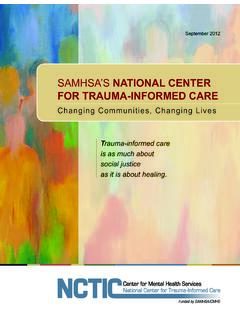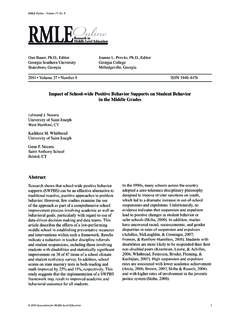Transcription of Trends and Patterns in Crime: Past, Present, and Future..
1 Department Of justice Office~of justice Programs Bureau of justice Assistance ,-- / ~6/% Trends and Patterns in crime : past , present , and West Compilation and Revision of Materials Presented at BJA's ".lustice in the New Millennium" Regional Conferences May -]une, 2000 PROPERTY OF National Criminal justice Reference Service (NCJRS) Box 6000 Rockville, MD 20849-6000 If you have issues viewing or accessing this file, please contact us at Department Of justice Office~of justice Programs Bureau of justice Assistance Lt ~7 Trends and Patterns in crime : past , present , and West Compilation and Revision of Materials Presented at BJA's " justice in the New Millennium" Regional Conferences May - June, 2000 PROPERTY OF National Criminal justice Reference Service (NCJRS) Box 6000 Rockville, MD 20849-6000 Trends and Patterns in crime .
2 past , present , and future Compilation and Revision of Materials Presented at BJA's " justice in the New Millennium" Regional Conferences May - June, 2000 Prepared by Community Research Associates, Inc. William V. Pelfrey, Consultant Virginia Commonwealth University November 2000 Bureau of justice Assistance 810 7 th Street, NW Washington, DC 20531 (202)514-6278 Community Research Associates, Inc. 311 Plus Park Blvd., Ste 100 Nashville, TN 37122 (615) 399-9908 309 West Clark Street Champaign, IL 61820 (217) 398-3120 400 N. Columbus Street, Ste 205 Alexandria, VA 22314 (703) 519-4510 This project was supported by Cooperative Agreement No. 95-DD-BX-K001 awarded by the Bureau of justice Assistance, Office of justice Programs, Department of justice to Community Research Associates, Inc.
3 The Bureau of justice Assistance is a component of the Office of justice Programs. Points of view or opinion in this document are those of the author and do not necessarily represent the official position or policies of the Department of justice and Community Research Associates, Inc. Table of Contents Executive Summary .. 1 Introduction .. 11 crime Trends and Patterns : Northeast Region .. 15 Southeast Region .. 49 North Central Region .. 83 South Central Region .. 119 West Region .. 151 Methodology .. 185 References .. 191 Trends and Patterns in crime : past , present , and future Compilation and Revision of Materials Presented at BJA's " justice in the New Millennium" Regional Conferences May - June, 2000 Executive Summary In preparation for presentations at the " justice in the New Millennium" regional conferences, existing datasets were identified, explored, collated, and assessed on crime , arrests, demographic projections, and social issues.
4 These data were organized so that similar presentations could be made at Regional Conferences but tailoring the data to be specific to that region and the jurisdictions comprising it. The objective was to provide a snapshot of the past Trends or Patterns related to violent crime and drug use and comments of future Trends or Patterns . This was a daunting task but one which seemed imminently logical considering the topic for the Regional Conferences, justice in the New Millennium. The manifest purpose was to provide clear, albeit general, information on crime and drugs in the jurisdictions. The latent purpose was to promote interest and enquiry into other ways of exploring, assessing, identifying and addressing issues such as crime and disorder, utilizing crime data but also utilizing social and demographic data in a fashion defensible based on criminological theory.
5 For each of the regional presentations, crime and arrest data were used to describe the nature and extent of the problem and demographic data were used to describe projected changes in the jurisdictions. Together the two types of information provided defensible comments about the future . Projections of demographic changes such as population growth, rates of change in the juvenile population, and race and ethnicity projections, are based on reasonably reliable information from governmental sources so there is a presumption of accuracy in these figures. Projections of social problems such as crime and drug use are much more problematic, however. The document concludes with a description of the Methodology used in these assessments.
6 It is clear from the comments about limitations of the data that they are not as reliable or valid as we would prefer. They do however, in the absence of better, more reliable, more valid data, represent the most useful information reasonably available for such a project as this. The main document has one section devoted to each of the five geographic Regions of the Bureau of justice Assistance (BJA), State and Local Assistance Division. The conclusion of each section includes comments and observations on crime problems and drug problems, not in a statistical probability fashion, that would be guaranteed to be incorrect, but in a narrative description, based on the information assessed. The five sections of the document are " crime Trends and Patterns " in each of the BJA regions that are designated as the Northeast, Southeast, North Central, South Central, and West Regions.
7 This Executive Summary also includes the concluding comments from each of the sections as well as general comments on the nation. The format of each section of this publication is consistent with that of the regional presentations during the " justice in the New Millennium" regional conference. There is redundancy in the format but the data and information for each section is tailored to apply to those jurisdictions within each region. The objective for the regional presentations and the objective for this publication is to provide policy makers with the best, most current information on crime and drug use, as well as demographic projections which are likely to affect the jurisdictions, so that better, more appropriate plans can be derived from the data.
8 Violent crime Violent crime in the United States is lower than it has been in many years. The FBI's Uniform crime Report for 1998, crime in the United States notes "In 1998, the lowest national violent crime rate since 1985 was recorded .. " While this is an appreciated trend, there are still problems. Most states have shared in the decline in violent crime seen in recent years. In observing Trends in crime , however, it appears that there are states which have not participated in the same levels of decline or which still have unusually high rates of violent crime . Within each region, states will be discussed but it is important to view some Patterns nationally. The jurisdictions in the United States with the highest average violent crime rates from 1996 through 1998 were: District of Columbia Louisiana Florida Illinois South Carolina California New Mexico Tennessee Maryland Nevada These jurisdictions were identified by averaging the violent crime rates, per 100,000 population for the District of Columbia and each state in the Nation for 1996, 1997 and 1998.
9 Average rates were used in an effort to "smooth" annual variations and gain a more accurate impression of levels of violence, as recorded by the Uniform crime Reporting (UCR) Program. Violent crimes are defined as murder, rape, robbery, and aggravated assault, consistent with the UCR definitions. While each of the jurisdictions listed above had violent crime rate averages of 750 per 100,000 population or greater (the violent crime rate in 1998 was per 100,000 population), the range was significant among those jurisdictions. Nevada, with the lowest average of the top ten, had violent index crimes per 100,000 population while the District of Columbia had more than 2,000 per 100,000 population.
10 Other jurisdictions had unusually high rates of certain violent crimes. The jurisdictions with the highest average murder rates for the three year period were: District of Columbia Nevada Puerto Rico Maryland Louisiana New Mexico Mississippi Each of these jurisdictions averaged more than l0 murders per 100,000 persons. It should be noted that all of these jurisdictions realized decreases in murder rates, comparing the average for the three years to the rate seen in 1998, except New Mexico that realized an increase in the murder rate from 1997 to 1998. Puerto Rico had an average murder rate of almost 20 per 100,000 population for the three year period but even that was low in comparison to the murder rate of the District of Columbia at per 100,000 population.














